ADF Tracking
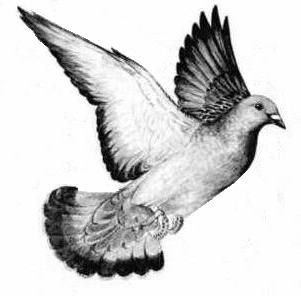
Homing is Unacceptable
Homing is easy and instinctive, but it is also inefficient and potentially dangerous. Homing to a station simply means pointing the aircraft in the direction of the station. The easiest way to do this is to turn the aircraft in the direction of the ADF needle until the needle points to the top of the indicator.
The pilot compensates for the wind by keeping the ADF needle centered with heading adjustments. With the wind constantly pushing from one side, the pilot has to constantly change the heading as he proceeds toward the station to keep the needle on the nose. With homing the crosswind pushes the aircraft away from the direct course and the resulting path to the station will be curved.
The series of illustrations below graphically show why homing is undesirable. To the left the aircraft begins homing to the 090° NDB bearing with a 090° heading. The crosswind from the north blows the aircraft off course, to the south. The following images of the aircraft show how it's heading has to be adjusted to maintain the ADF needle on the nose as the wind blows from the North. As it nears the NDB the wind has blown the airplane so far off the inbound bearing that, to keep the needle on the nose, it must fly a heading of 020° instead of the desired 090°.
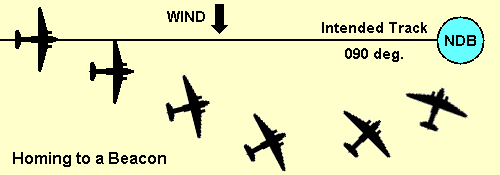
With a crosswind, homing results in a curved flight path to the NDB.
Homing is unacceptable for IFR navigation because the aircraft strays too far from the intended course. The wide, looping course shown in this illustration could take it into a hill, a radio tower, or other obstruction at the minimum altitudes of an NDB approach.
Continually turning towards the wind to keep the needle centered as the aircraft approaches the beacon is sometimes called "Birdogging." In strong wind conditions ADFs gradually drift your aircraft heading toward the wind direction as you approach the station.
Tracking
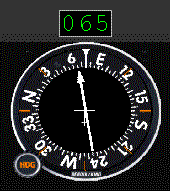
The only way to fly a straight course to a station is to track to the station. Tracking means to establish a wind-correction angle that negates the drift caused by the crosswind.
Again, rely on the rule to turn toward the pointer to intercept any course being paralleled. This rule applies whether flying inbound or outbound.
Once you have intercepted the desired bearing, hold that heading and see what effect the wind has. Let's continue with the previous example, intercepting and tracking the 075° bearing to Provincetown's Runway 7—and see what happens.
The ADF gauge above shows that a crosswind from the left has blown our aircraft off course. Our heading is still 075°, but the airplane has drifted off the bearing by 10°. The bearing to the PVC beacon is now 065°—the needle points to 065°. A turn to the left, towards the needle, is necessary to return to the desired 075° bearing. But how much correction is needed to stay on course?
![]()

![]()
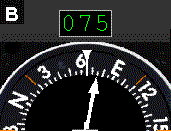
![]()
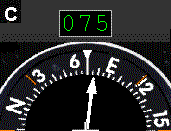
- To get back on course, double the drift first noted and turn toward the needle by that amount, in this case 20° relative, or to a 055° heading. You are reintercepting the bearing.
- Hold the intercept heading of 055° until the needle returns to 075°, the desired bearing to the station. Now reduce the correction by half—10° in this case—to a heading of 065° to compensate for the wind. You should also lead the turn back on track by two to five degrees, depending on how far you are from the station.
- This method of correcting for wind drift is called bracketing. You may have to "bracket" several times to establish a reference heading that keeps you on the desired bearing, especially if a long distance from the station. The initial wind correction may be too large or too small to stay on the bearing. If so, adjust the correction. In example C, if the 10° correction (065° heading) proves too much, reintercept the bearing and try a 5° correction with a 070° heading.
Chasing the needle is a common mistake in ADF intercepts, tracking and bracketing. It is so tempting to follow that moving needle. Resist that temptation! Hold the heading steady until the needle reaches the relative bearing that you want, then make the turn.
Near the station the ADF needle will become "nervous," start wiggling and become more sensitive. Again, don't chase the needle, just fly the reference heading. The needle will start to swing to the left or right on passing over a station.
Wait until the needle has definitely swung around to verify station passage—at least five to ten seconds past the ADF station. Then turn to the outbound magnetic heading to determine which side of the bearing you are now situated and how much you will have to correct.
Practice flights, tracking inbound
Tracking inbound really is a simple procedure as you have just read. The two flights next described will polish up your inbound tracking skills. Complete the Flight Planning Worksheet before beginning each flight.
Long Island to Meriden, Connecticut
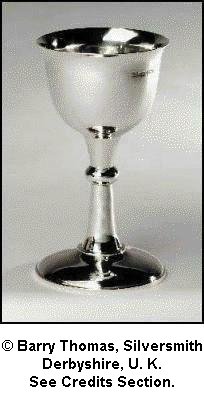
"What's going on in Long Island?" I asked the Boss. His message on my pager said to call, urgent.
"It's Counter, again," he replied. "Seems his Administrative Assistant is threatening to quit. His A.A. has a passion for hand-made silver and so Counter wants to fly to Meriden this afternoon."
"Meriden?"
"Yeah," the boss interrupted. "It earned the title of 'Silver City of the World' for the great hand-made stuff there. Counter figures if he can get there fast enough and buy something really cool, his A.A. won't quit. I don't understand the big deal, I mean, isn't the A.A. a clerk, a dime a dozen?"
"I think Counter's A.A. has more talents than that," I suggested. I had seen her and she was a knockout. Scuttlebutt had it that she had been a finalist in a local beauty-queen pageant a year or so back.
"Yeah, you're probably right. They get to know the inner workings of the company—that increases their value."
I didn't see the need to bring him up to speed. "The weather on the Sound isn't looking too good ... overcast and lousy visibility."
"Counter said he'd pay a bonus if you get him there and back today," the Boss offered, sensing my reluctance.
I hung up and headed for the airport. It seemed like I was now Mr. Benjamin Counter's private airline.
- Today's weather is poor. Set in 1500 ft. overcast with a visibility of 3 miles. Start the timer at the beginning of your takeoff roll. Depart from The Gabreski airport, KFOK, on Long Island, New York, using Rwy 33. Your destination is Meriden, Connecticut, KMMK. Tune in the Meriden NDB—"MMK"—on 238 kHz. On departure turn right to the 001° bearing to MMK, 41 nm. distant. You may not receive the MMK NDB until three or four minutes after departure. Climb to 3000 ft. Your flight time will be 25 minutes at 110 kts. cruise. Fifteen minutes into the flight begin a 500 fpm descent, maintaining 110 kts. Slow to approach speed on reaching 1000 ft., 500 ft. below the overcast. Continue tracking inbound on the 001° bearing until sighting the airport and Rwy 36 then execute a visual landing. Field elevation is 101 ft.
- Same route, same weather, but the wind has picked up. It's now 30 kts from 310°. Note: prior to starting your takeoff roll your airspeed indicator will read about 28 kts. That is from the strong surface headwind which will considerably shorten your takeoff run (but lengthen the flight).
Hopefully, by now you have downloaded and installed the Virtual E6-B Computer. If so, here are the numbers that you should have calculated for climb (90 kts IAS) and Cruise (110 kts IAS):
Total Distance of flight 41 NM Time to climb to 3000 ft @ 700 fpm 4.2 minutes Ground speed during climb 68 kts WCA During Climb 15° L Magnetic Hdg during Climb 346° Distance during climb 5 NM Distance for Cruise & Descent 36 NM Ground Speed during Cruise & Descent 89 kts WCA during Cruise & Descent 12° L Magnetic Hdg during Cruise & Descent 349° Time to Cruise 36 NM at 89 kts 24 minutes Total Time En Route 28 minutes With these numbers, now proceed as in the previous flight.
NOTE: Obviously one doesn't descend at 110 kts all the way to the runway threshold, but slows to enter the traffic pattern. Adding five minutes to the calculated ETE gives a good approximation of your actual flight time.
Click here to print the information for these two flights.
These flights will be pretty well under control after you fly each of them two or three times. You will be a busy pilot en route, too.
It is extremely important that you listen to the Morse-code identifier for any beacon that you are tracking to or from and verify that it is the proper NDB. Since NDBs operate in the LF band they can have great range. Click the center of the face of the radio for the ident function. A second click discontinues the ident.
flying may produce entirely opposite results.
Outbound Bearings from the NDB
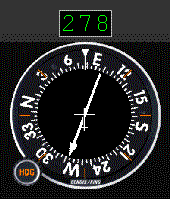
The procedures to intercept, track, and bracket outbound NDB bearings are very similar to those used on inbound bearings. The difference is that we work with reciprocals of the headings.
Limit outbound maneuvers to course corrections to compensate for crosswinds. It's not smart to intercept an outbound bearing en route because no information exists on where you are ... one nm. from the beacon or 30 nm. from the beacon? One traditionally enters an outbound leg at station passage, i.e., from a known position.
Assume that the last leg of your flight tracks outbound on the 078° bearing from the FFF beacon to Provincetown's Runway 7. The bearing from your aircraft to the beacon will be the reciprocal, or 258°, which is where the ADF pointer should be. Here the ADF indicator shows the aircraft's heading is 078°. But the ADF needle, pointing behind you to the FFF beacon, isn't on 258°. It's on 278°—you've drifted 20° off course.
Point number one. Just as tracking inbound to a beacon, if you are paralleling the desired path outbound, the pointer arrow shows you which way to turn to get back on course. Here the arrow points to the left so turn the aircraft to the left
Follow the same procedure as when intercepting an inbound bearing, Double your 20° error and turn towards the POINTER of the ADF needle, to the left by 40°.
![]()
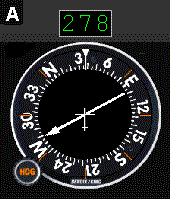
![]()
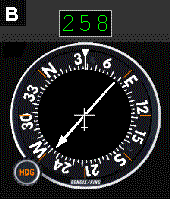
![]()
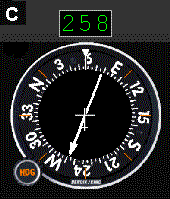
- With a 40° turn to the left for intercept, the aircraft heading will be 078°–040° or 038°. Notice that the pointer has swung farther away from the tail of the plane. That confirms that your turn was in the correct direction when flying outbound.
- Maintain a 038° heading until the ADF needle nearly reaches the desired 258° bearing from the aircraft to the beacon.
- Turn right to 058°, one-half of the initial correction angle, and track outbound with the pointer on 258° to the station. If you continue to drift off course, repeat the bracketing steps until the track is correct. Bracket outbound the same as on an inbound leg, except determine the wind correction necessary using reciprocals.
In actual practice, one would not drift so far off course as this example, to require a 40° intercept angle. Large numbers were used here so that the procedures would be clearly visible on the ADF indicator. Run through these procedures two or three times on your Flight Simulator to make everything click together.
Remember that the needle always points to the station. Never put the needle on the tail by changing the heading. This will cause you to miss the bearing completely and, as you will see during an NDB approach, if you lose that outbound bearing, you miss the airport.
Norwood, Massachusetts to Falmouth, Massachusetts

I was in the pilot's lounge relaxing after a tough IFR flight. We had been in the soup the whole time. I lapsed into a day-dream about my last CAVU flight—Ceilings and Visibility Unlimited—when our receptionist tapped me on the shoulder. I looked up and she nodded in the direction of the Boss's office. Without a word I got up and walked over.
"Is your aircraft fueled?" he asked before I could sit down.
"Yep, topped up, oil checked and windscreen polished," I replied, lowering myself into a battered chair.
"Good," he responded. "because I just got off the phone with Mr. Airline-CEO Counter. He missed his commuter flight to Falmouth, Massachusetts this morning, and there won't be another until tomorrow morning, which would be embarrassing."
I contemplated that for a moment but nothing came to mind that would embarrass Counter.
The Boss went on, "Counter is the scheduled Commencement speaker tonight at his alma mater, Downhome University of Hillsdale. They requested him to speak because of his rise in industry and his insistence that business success is directly tied to punctuality. It will not send a good message if he misses that commitment because he over-slept his flight. He requested your services because you can keep your mouth shut, whatever on earth that's all about."
A picture of his administrative assistant flashed across my mind and some of the destinations where the two had met for "business" purposes.
"He's in Norwood, Mass., so leave for there as soon as you can get the engine cranked up and get him to Falmouth. There's a bonus for both of us if you can make it look like the charter was planned from the start," the Boss said with finality.
I rose to leave when the Boss added, "And it doesn't help his humor or increase his desire to charter our services if you remind him of his alma mater's initials."
Downhome University of Hillsdale. What could I say?
Practice flights, tracking outbound
Two practice flights are listed below that will sharpen your skills at intercepting and tracking an outbound radial using the ADF. Although the routes are the same, the flights differ. Try to fly each flight once a day until you have nailed the procedures. That will happen very quickly.
Concentrate on staying on the 151° outbound bearing. In case your calculator is broken, the reciprocal of 151° is 331°. A one-degree deviation puts you off course by 0.6 NM. at the end of the 38 NM outbound leg from OW NDB. This is a long distance to track outbound, especially to arrive at a runway. That's why these are such good practice flights.
Enjoy the flights. It will be a busy 24 minutes.
- Tune your ADF to 397.0 kHz, STOGE NDB (OW), and tune Nav-1 to 115.8 MHz, (FMH). FMH is a TACAN Station, and your VOR needle will not respond; we use this signal for DME information only. Wind is calm. Start the timer at the beginning of your takeoff roll. Depart from Rwy 17, KOWD, Norwood, Massachusetts, climbing to 3500 ft. Destination is Otis Air National Guard Field, KFMH, Falmouth, Massachusetts, with field elevation of 131 ft. Fly direct to OW NDB, then turn left and track the 151° radial outbound from STOGE NDB to Otis ANG Field. RMI Needle will point to 331°. You will track almost 38 NM outbound from OW NDB, landing Otis Rwy 14. ETE from Norwood Memorial Airport is 24 minutes. Begin your 400 fpm descent 15 DME from FMH VOR (TACAN). Leave your ILS OFF during this flight!
- Same route as above, except that we add some complexity and reduce the visibility to 3 miles and the cloud cover to overcast, base at 1100 ft. Set in a 20 kt wind, from 130°. Calculate your WCAs and Ground speeds for Climb and Cruise before departure. Same en route details as previous flight, except altitude will be 3000 ft. and begin your 400 fpm descent 13 DME from FMH VOR (TACAN). Land Rwy 14. Leave your ILS OFF for this flight!
Click here to print the information for these two flights.
After successful completion of these two flights, you'll easily master the next piece, NDB approaches.
NDB Approaches
There are two types of NDB approaches: an inbound approach, if the station is on the field; and an outbound approach if the station is some distance from the field. The next section discusses each of these approaches in detail.
Holding Patterns
Holding patterns, you may remember, was not among the navigation procedures listed earlier that would be reviewed. In the late 1940s they were important and frequently used. Circumstances still exist today when they are required. But holding patterns are not covered here because they usually are in response to an ATC instruction or, in the event of a missed approach, while awaiting an ATC instruction. Since interactive voice communication with Flight Simulator is limited to On-Line Flying, VATSIM, holding procedures in response to an ATC instruction will not be reviewed here.
Click on the NDB Approaches button for your first instrument approaches.
Site best viewed at 600 × 800 resolution or higher.
© 1999 – 2008, Charles Wood.

